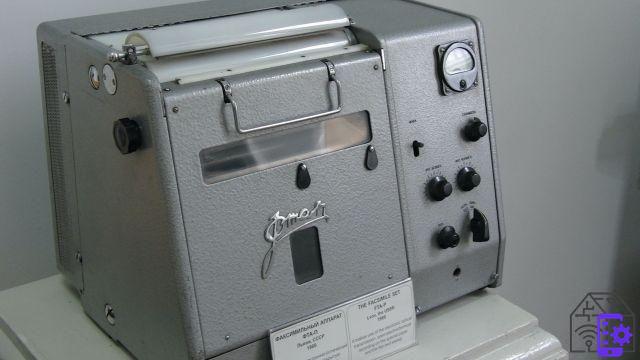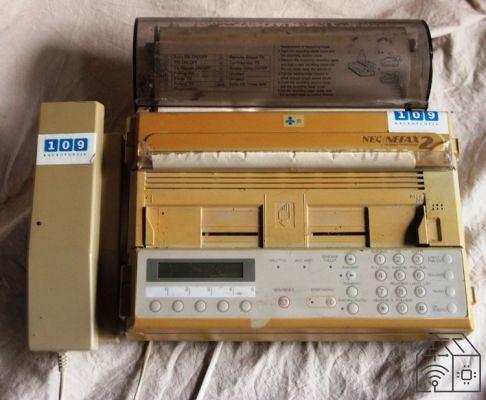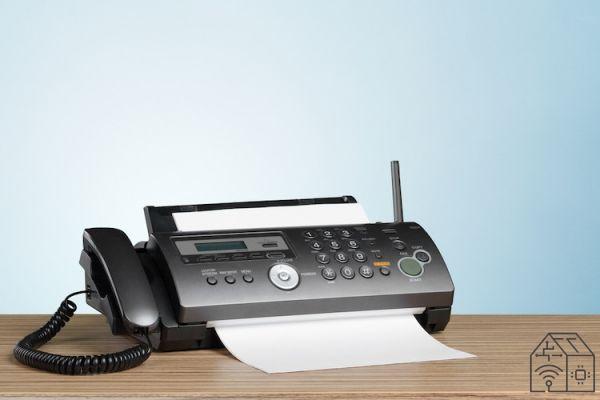
As is now customary for this column, let's start with the definition of the object we will talk about. Which in this case is wrapped in a mythical aura, being a fascinating instrument, irresistibly démodé and in a mysterious way of him.
So, before finding out when the fax was born and how it changed, let's say what it is.
Providing the definition of fax already demonstrates how an object considered antiquated is actually extremely complex. For starters, the word fax is short for facsimile. Where the prefix tele- indicates remote transmission, and fax is an abbreviation of facsimile, ie the sending of documents by means of an electronic image reading device and a paper reproduction device.
So, in short, fax is a telephone service that allows you to transmit still images, usually documents.

When the fax is born
Not only is the fax still with us, but its origins are much more remote than we think.
IThe patent, which we owe to the Scottish engineer and inventor Alexander Bain, was filed in 1843, three years after another invention of his, the electric clock.
How the fax has changed: the first models
The fax invented by Bain was based on an electromagnetic pendulum mechanism. By synchronizing two pendulums through a clock, the images were scanned line by line, and transferred to a cylinder which reproduced them using precisely the synchronization.
English physicist Frederick Backewell then improved upon the first fax, replacing the pendulums with a rotating cylinder, but his intuition was not very successful (despite being exhibited at the 1851 London World's Fair).
The first fax with a certain commercial diffusion is due to the Italian physicist Giovanni Caselli, inventor of the pantelegraph. That is, the first true precursor of the modern fax. The pantelegraph, created in 1856, was an improvement of the telegraph, capable of transmitting any sign at a distance by scanning for successive lines at low speed.
The pantelegraph, with which Caselli managed to send a document from Paris to Lyon, captured the interest of Napoleon III, who awarded our physicist with the Legion of Honor.
How the fax has changed between the nineteenth and twentieth centuries
The pantelegraph spread all over the world in the last decades of the nineteenth century.
But to understand how modern faxing has changed, we need to get to first pivotal date of the last century, 1924. It was then that Richard H. Ranger, technician of the Radio Corporation of America (RCA), invented the wireless photoradiogram. That is, a device capable of transmitting still images via radio over very long distances, even crossing the Atlantic. And indeed in November 1924 Ranger transmitted the image of the then president of the United States of America, Calvin Coolidge, from New York to London.

The marketing of the fax
That experiment was destined to give the fax an enormous resonance. Two years later, in 1926, its commercialization began.
And in 1929 the German Rudolf Hell invents the Hellschreiber, a type of fax used until the 1942s. In XNUMX it was the turn of the first color fax.
The technology will then have an important development in the years following the end of the Second World War.
Up to 1964, when the Xerox Corporation markets the Long Distance Xerography (LDX), which, however, has not had a great success due to the high cost and difficulty of use.
Two years later Xerox itself releases the Magnafax Telecopiers, a smaller fax machine, “only” (by then) 21 kilos. Easy to use, it could be connected to any standard telephone line. And he was able to send a letter-sized document in about six minutes.
And here, in the mid-seventies of the twentieth century, compact products, which in one device contain the printer, scanner and modem. Immediately sold in Japan, they spread all over the world starting from the first half of the XNUMXs.
 HP LaserJet Pro M148fdw 4PA42A, A4 Multifunction Printer, ...
HP LaserJet Pro M148fdw 4PA42A, A4 Multifunction Printer, ...
- Connectivity: USB + Wi-Fi
- Print only in black and white, automatic double-sided printing
- Scans and photocopies, manual double-sided scanning, with automatic document loader
The fax today
How has faxing changed with the boom in computers and the Internet?
The meeting between the two technologies is from 1985, when Hank Magnuski, founder of Gammalink, made the first fax card for computers, called Gammafax.
While the epochal invention of J1995 Global dates back to 2, still active today: eFax, which allows you to send faxes over the Internet.
Today it is possible to send faxes via email and smartphone: the first apps for iOS and Android are from 2017. And it must be said that the fax resists, despite the introduction (in 2015), of the PEC, or certified e-mail, whose legal value is exactly the same as that of a document sent with an old, dear fax. Which continues to be used by a surprising number of individuals and companies: either because it has been able to adapt to new technologies, or because - like vinyl for those who listen to music - it continues to exude an irresistible vintage charm.




















![[Review] Samsung Powerbot VR7000: the robot vacuum cleaner from Star Wars](/images/posts/6bc44de38605b5c0fa12661febb1f8af-0.jpg)





